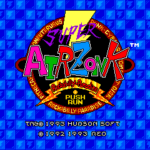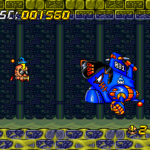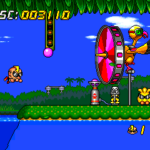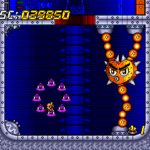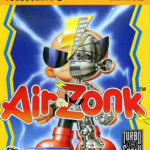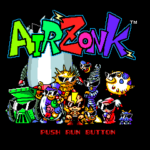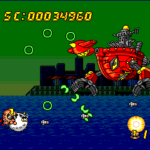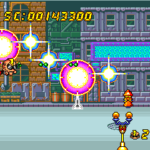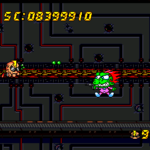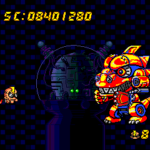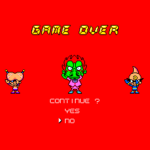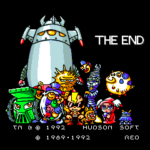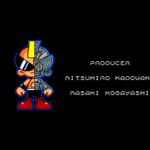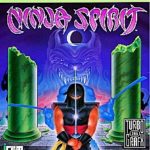 Irem’s 1988 title Ninja Spirit is reportedly the first TurboGrafx-16 title to receive a perfect 10 from EGM upon its release in 1988. My memories of this game are fond: the high-leaping ninja, his mirror clones and, of course, that first boss. Returning to this game was a mostly-positive experience marred, once again, by the inordinate difficulty spike common for games of the time.
Irem’s 1988 title Ninja Spirit is reportedly the first TurboGrafx-16 title to receive a perfect 10 from EGM upon its release in 1988. My memories of this game are fond: the high-leaping ninja, his mirror clones and, of course, that first boss. Returning to this game was a mostly-positive experience marred, once again, by the inordinate difficulty spike common for games of the time.
The game’s familiar intro begins with our hero’s father being killed by an unspecified green glob attack. Moonlight, the protagonist who strangely is a wolf, begins his quest for vengeance. The game’s presentation is highly stylized and entirely over-the-top. Equipped with several possible weapons, my playthroughs often stuck with the standard sword, despite its weakness in several cases. Having up to two mirror images of yourself plus shadowy sword trails make for a memorable introduction. Ninja enemies spawn from everywhere, throwing daggers and filling the screen with impressive sprites. As you get accustomed to the incredibly-floaty physics, the first stage’s boss appears, an utterly-massive, six-armed demon. He is by no means difficult, but virtually anyone who has played this game recalls his striking appearance. I’d imagine this was the biggest boss for any game at the time, 30 years ago.


The relative simplicity of the first stage is forgiving, particularly on the TurboGrafx mode which allows several hits from minor characters before death. The arcade original did not have this and as the game progresses, most non-croney enemies will still result in a one-hit death. Using your clones to block and attack while you remain safe at a distance is a great method, but certain foes take an awful lot of hits. As stages progress, memorization is your ally – these guys get difficult! The vertical stage is reminiscent of Contra and the bosses never get as surprising as stage 1, at least until the end. More on that in a minute.
The music isn’t far from what you’d expect from a 1988 title. It is dark and mysterious, entirely fitting for a shadowy ninja game. The tracks aren’t entirely memorable, but they suit the title perfectly. I suppose, in retrospect, I never quite found a better ninja title in my gaming days. I never got into Ninja Gaiden (outside the original and brutal trilogy in the ’80s) and need to return to Nioh, which was rather good. We’ll see if Sekiro can trump this upon its release next spring. I digress.


Running along the ceilings in later stages and battling baton-wielding toads all gets very rigorous. The screen is littered with enemies and flying attacks making survival without powered-up weapons a chore. Though enemies carrying those perks are numerous, sometimes getting to them is suicide – perhaps a good risk-versus-reward balance.
But then after you’ve survived the last levels of memorization and mania, you’re ready to descend the pit towards the final boss. As difficulty goes in games, this is just stupid. The aforementioned pit is literred with flying ninjas, swords held high. You jump into said chasm blindly and one hit from any of these hundreds of foes will end you. Descending through these guys is quite literally the definition of memorization because after a few lost lives, you’re forced to repeat the entirety of the fifth stage. And by that, you’re just running as fast as you can to avoid ninjas that take multiple hits but who can kill you in one and these deadly puffs of gas that don’t seem to affect aforementioned super-powered ninjas. Yes, memorize this pattern because after the run-away technique and the memorize this one-hit-death pit of stupidity, you reach the boss. This guy’s green snaky attacks are what killed your father – though we never really learn why. My method here was to throw shurikens and run away like my own life depended on it. The unnamed boss doesn’t move, fortunately, but after all these sequences of precision and stress, that’s good. It’s OK if you die to him, you can redo that ‘falling in a pit of flying fucking ninjas’ all over again!
This guy’s green snaky attacks are what killed your father – though we never really learn why. My method here was to throw shurikens and run away like my own life depended on it. The unnamed boss doesn’t move, fortunately, but after all these sequences of precision and stress, that’s good. It’s OK if you die to him, you can redo that ‘falling in a pit of flying fucking ninjas’ all over again!
The credits sequence has cool half-screen images of all seven bosses with their chapter names written in elegant Chinese. You’re then presented with some semblance of a story, about you having saved the day, but it doesn’t matter, evil will just return. Inspirational! Now go back and play it on arcade mode!
Final Verdict
 I’d play Ninja Spirit again. But I don’t know if I would care to try beating it again. To be fair, the hour-long experience fit right in for the time. Had you purchased a $50 game and beat it in one sitting, you would be disappointed. The 25-hour experiences of today were virtually unheard of back then and this was an arcade port, remember! However, while the setting, ambience and feel are familiar and wonderful, the rigor of the end-game makes it difficult to appreciate nowadays. I’m wholeheartedly glad to have returned if only for the sheer glee of revisiting that first stage. There’s a nice sound test where you can listen to all the music and there are also curious messages unlocked by a code – good for a laugh, I suppose. Much like the prior entries into this retro-gaming list, the first levels of this game are a lot of fun and worth a try. I’m glad I’m embarking on this journey. I’m thinking Gunstar Heroes next.
I’d play Ninja Spirit again. But I don’t know if I would care to try beating it again. To be fair, the hour-long experience fit right in for the time. Had you purchased a $50 game and beat it in one sitting, you would be disappointed. The 25-hour experiences of today were virtually unheard of back then and this was an arcade port, remember! However, while the setting, ambience and feel are familiar and wonderful, the rigor of the end-game makes it difficult to appreciate nowadays. I’m wholeheartedly glad to have returned if only for the sheer glee of revisiting that first stage. There’s a nice sound test where you can listen to all the music and there are also curious messages unlocked by a code – good for a laugh, I suppose. Much like the prior entries into this retro-gaming list, the first levels of this game are a lot of fun and worth a try. I’m glad I’m embarking on this journey. I’m thinking Gunstar Heroes next.






